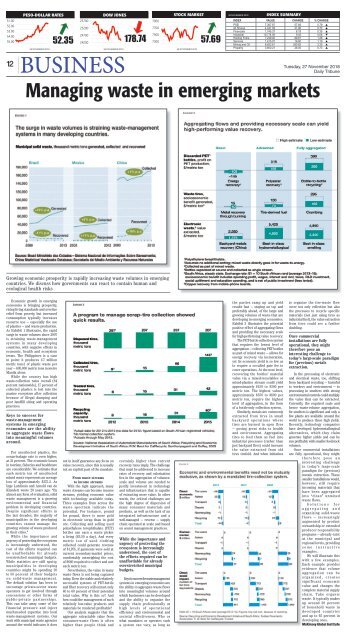27 NOVEMBER 2018_1
Create successful ePaper yourself
Turn your PDF publications into a flip-book with our unique Google optimized e-Paper software.
51.00<br />
52.00<br />
53.00<br />
54.00<br />
55.00<br />
PESO-DOLLAR RATES<br />
26 <strong>NOVEMBER</strong> <strong>2018</strong><br />
52.35<br />
12<br />
BUSINESS<br />
25700<br />
25200<br />
24700<br />
24200<br />
DOW JONES<br />
26 <strong>NOVEMBER</strong> <strong>2018</strong><br />
178.74<br />
7900<br />
7700<br />
STOCK MARKET<br />
7500<br />
7300 57.69<br />
26 <strong>NOVEMBER</strong> <strong>2018</strong><br />
26 <strong>NOVEMBER</strong> <strong>2018</strong><br />
INDEX SUMMARY<br />
INDEX VALUE CHANGE % CHANGE<br />
PSEi 7,397.87 57.69 0.79 ▲<br />
All Shares 4,441.09 31.86 0.72 ▲<br />
Financials 1,745.37 6.18 0.35 ▲<br />
Industrial 10,774.59 9.05 0.08 ▼<br />
Holding Firms 7,239.40 89.81 1.26 ▲<br />
Services 1,415.07 16.60 1.19 ▲<br />
Mining and Oil 8,653.61 280.65 3.35 ▲<br />
Property 3,600.21 26.05 0.73 ▲<br />
Tuesday, <strong>27</strong> November <strong>2018</strong><br />
Daily Tribune<br />
Managing waste in emerging markets<br />
Growing economic prosperity is rapidly increasing waste volumes in emerging<br />
countries. We discuss how governments can react to contain human and<br />
ecological health risks<br />
Economic growth in emerging<br />
economies is bringing prosperity,<br />
rising living standards and overdue<br />
relief from poverty, but increased<br />
consumption typically increases<br />
resource use — especially the use<br />
of plastics — and waste production.<br />
As Exhibit 1 illustrates, the rapid<br />
surge in waste volumes since 2007<br />
is straining waste-management<br />
systems in many developing<br />
countries, with negative effects in<br />
economic, health and ecosystem<br />
terms. The Philippines is a case<br />
in point: it produces 2.7 million<br />
metric tons1 of plastic waste per<br />
year — 600,000 metric tons in metro<br />
Manila alone.<br />
While the country has high<br />
waste-collection rates overall (84<br />
percent nationwide), 17 percent of<br />
collected plastics is lost into the<br />
marine ecosystem after collection<br />
because of illegal dumping and<br />
poor landfill siting and operating<br />
practices.<br />
Keys to success for<br />
waste-management<br />
systems in emerging<br />
economies are the ability<br />
to aggregate waste flows<br />
into meaningful volumes<br />
around.<br />
For uncollected plastics, the<br />
ocean-leakage rate is even higher,<br />
at 31 percent. The economic losses<br />
in tourism, fisheries and healthcare<br />
are considerable. We estimate that<br />
each metric ton of uncollected<br />
mixed waste represents an average<br />
loss of approximately $375.3. As<br />
Inge Lardinois and Arnold van de<br />
Klundert wrote 20 years ago: “By<br />
almost any form of evaluation, solid<br />
waste management is a growing<br />
environmental and financial<br />
problem in developing countries.<br />
Despite significant efforts in<br />
the last decades, the majority of<br />
municipalities in the developing<br />
countries cannot manage the<br />
growing volume of waste produced<br />
in their cities.”<br />
While the importance and<br />
urgency of protecting the ecosystem<br />
is increasingly understood, the<br />
cost of the efforts required can<br />
be unaffordable for already<br />
overstretched municipal budgets.<br />
While statistics are still spotty,<br />
municipalities in developing<br />
countries might be spending 20<br />
to 50 percent of their budgets<br />
on solid-waste management.<br />
The default solution has been to<br />
encourage private-sector waste<br />
operators to get involved through<br />
concessions or other forms of<br />
public-private partnerships.<br />
This can take away some of the<br />
financial pressure and inject<br />
much-needed expertise into local<br />
waste-management systems. Our<br />
work with municipal waste agencies<br />
around the world indicates it does<br />
not in itself guarantee any focus on<br />
value recovery, since this is usually<br />
not an explicit part of the mandate.<br />
From waste streams<br />
to income streams<br />
With the right approach, many<br />
waste streams can become income<br />
streams, yielding economic value<br />
with technology available today.<br />
Three examples from across the<br />
waste spectrum indicate the<br />
potential. For instance, pound<br />
for pound, there is more gold<br />
in electronic scrap than in gold<br />
ore. Collecting and selling used<br />
polyethylene terephthalate (PET)<br />
bottles can earn a waste picker<br />
a living ($3.50 a day). And every<br />
metric ton of used clothing<br />
collected could generate revenue<br />
of $1,975, if garments were sold at<br />
current secondary-market prices,<br />
comfortably outweighing the cost<br />
of $680 required to collect and sort<br />
each metric ton.<br />
Nevertheless, the value in many<br />
waste flows is not being captured<br />
today. Even the stable and relatively<br />
successful systems of PET-bottle<br />
and fiber recovery still extract only<br />
40 to 60 percent of their potential<br />
total value. Why is this so? And<br />
how could the management of such<br />
relatively low-value products and<br />
materials be rendered profitable?<br />
Our analysis suggests that the<br />
aggregate extractable value from<br />
consumer-waste flows is often<br />
higher than people think and<br />
certainly higher than current<br />
recovery rates imply. The challenge<br />
that must be addressed to increase<br />
rates of recovery and valorization<br />
lies in the aggregation of volumes:<br />
scale and volume are needed to<br />
justify investment in technology<br />
and infrastructure that is capable<br />
of extracting more value. In other<br />
words, the critical challenges are<br />
the high degree of dispersion of<br />
many consumer materials and<br />
products, as well as the lack of an<br />
integrated infrastructure and a<br />
well-managed — reverse — supply<br />
chain operated at scale and based<br />
on sound management practices.<br />
While the importance and<br />
urgency of protecting the<br />
ecosystem is increasingly<br />
understood, the cost of<br />
the efforts required can be<br />
unaffordable for already<br />
overstretched municipal<br />
budgets.<br />
Keys to success for waste-management<br />
systems in emerging economies are<br />
the ability to aggregate waste flows<br />
into meaningful volumes around<br />
which businesses can be developed<br />
and the ability to organize the<br />
supply chain professionally at<br />
high levels of operational<br />
efficiency and environmental and<br />
societal effectiveness. Who or<br />
what mandates or operates such<br />
a system can vary, as long as<br />
the parties ramp up and yield<br />
results fast — staying on top and<br />
preferably ahead, of the large and<br />
growing volumes of waste that are<br />
developing in emerging economies.<br />
Exhibit 2 illustrates the potential<br />
positive effect of aggregating flows<br />
and providing the necessary scale<br />
for high-performing value recovery:<br />
The PET-bottle-collection system<br />
that requires the lowest level of<br />
aggregation — collecting PET bottles<br />
as part of mixed waste — allows for<br />
energy recovery via incineration,<br />
yet its economic yield is so low as<br />
to require a so-called gate fee to<br />
cover operations. At the next level,<br />
recovering the bottles’ material<br />
value via a mixed-recyclables or<br />
mixed-plastics stream could yield<br />
approximately $150 to $300 per<br />
metric ton. The highest values,<br />
approximately $350 to $600 per<br />
metric ton, require the highest<br />
level of aggregation, in the form<br />
of a bottle-only collection system.<br />
Similarly, metals are commonly<br />
extracted from tires in small<br />
backyard operations where<br />
tires are burned in open fires<br />
— posing great risks to health<br />
and environment. Aggregating<br />
tires to feed them as fuel into<br />
industrial processes (rather than<br />
just backyard fires) could increase<br />
the value extracted from old<br />
tires tenfold. And when initiatives<br />
to organize the tire-waste flow<br />
cover not only collection but also<br />
the processes to recycle specific<br />
materials (not just using tires as<br />
industrial fuel), the value extraction<br />
from tires could see a further<br />
doubling.<br />
Once commercial<br />
installations are fully<br />
operational, they might<br />
therefore pose an<br />
interesting challenge to<br />
today’s large-scale paradigm<br />
for (precious) metals<br />
extraction.<br />
In the processing of electronic<br />
and electrical waste, too, shifting<br />
from backyard recycling — harmful<br />
to workers and environment — to<br />
processing in smelters with strong<br />
environmental controls could multiply<br />
the value that can be extracted.<br />
Currently, the required scale and<br />
hence waste-volume aggregation,<br />
for smelters is significant and only a<br />
few plants are available around the<br />
world to produce these high yields.<br />
Recently, technology companies<br />
have developed hydrometallurgical<br />
alternatives, which they claim<br />
generate higher yields and can be<br />
run profitably with smaller feedstock<br />
volumes.<br />
Once commercial installations<br />
are fully operational, they might<br />
therefore pose an<br />
interesting challenge<br />
to today’s large-scale<br />
paradigm for (precious)<br />
metals extraction. These<br />
smaller installations would,<br />
however, still require<br />
incoming materials that<br />
have been aggregated<br />
into “clean” unmixed<br />
waste flows.<br />
Solutions for<br />
aggregating and<br />
organizing solid-waste<br />
flows — increasingly<br />
augmented by product<br />
stewardship or extended<br />
producer-responsibility<br />
programs — already exist<br />
at the municipal and<br />
regional levels, providing<br />
some instructive<br />
examples.<br />
We will illustrate this<br />
with a few examples.<br />
Each example provides<br />
evidence that volume<br />
aggregation can be<br />
organized, creates<br />
significant economic<br />
value and changes the<br />
complete material supply<br />
chain. Take organic<br />
waste. It typically makes<br />
up around 30 percent<br />
of household waste in<br />
developed countries<br />
and up to 65 percent in<br />
developing ones.<br />
McKinsey Global Institute


















